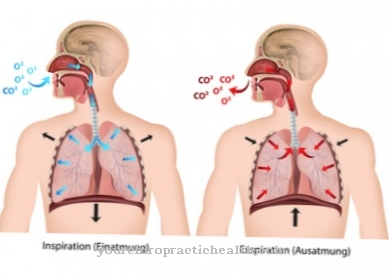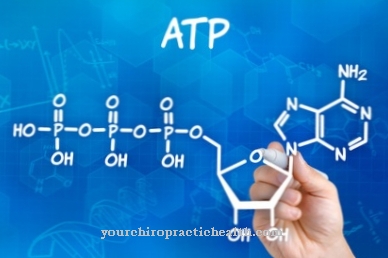With the tactile perception This refers to the passive sensation of touch, which together with the haptic perception corresponds to the sense of touch. In tactile perception, stimulus molecules from the environment bind to mechanoreceptors and are conducted into the CNS. Neurological diseases disrupt tactile perception.
What is tactile perception?

Haptic and tactile perception are summarized under the term of the sense of touch. Both types of perception are made possible by the human skin, which is the largest human sensory organ in terms of surface area. Thanks to the haptics, humans are able to actively touch objects and subjects. Thanks to tactile perception, he also feels passively when objects or subjects touch him. With these two perceptual qualities, the sense of touch is dependent on the sensorimotor and somatosensory system.
Tactile perception mainly relates to the recognition of mechanical contact stimuli, as they are essentially recorded via the so-called mechanoreceptors. Tactile perception largely corresponds to exteroception, i.e. the perception of stimuli from the environment. This is to be distinguished from interoception, which allows people to perceive stimuli from within the body. In the area of interoception, tactile perception is closely linked with the kinaesthetic system and thus influences the perception of position and the perception of the position of one's own body in space.
All tactile perceptual qualities of gross perception are referred to as protopathic sensitivity. The epicritical sensitivity describes the perceptual qualities of the fine perception.
Function & task
Tactile perception lets people feel. For this purpose, so-called mechanoreceptors are located in the human skin. Mechanoreception is the absorption of mechanical stimuli from the environment, which are converted into electrical signals in the mechanical receptors.
The mechanoreceptors bring the stimuli into a form that the central nervous system can process. The respective stimuli correspond to a mechanical deformation of the tissue via pressure or stretching. In the cell membrane of the receptors there are cation channels that are closed when the cell is at rest. The channels are connected to the cytoskeleton of the receptors via microtubules. When stretched or compressed, the microtubules exert tension on the ion channels. In this way, the channels are opened and cations flow in, which depolarize the cell beyond its resting potential. The sensory cells then either generate action potentials with a frequency in relation to the receptor potential or they release neurotransmitters in relation to the receptor potential.
The mechanoreceptors of the sense of touch are either SA receptors, RA receptors, or PC receptors. SA receptors are responsible for the sensation of pressure and contain the Merkel cells, the Ruffini bodies and the Pinkus Iggo tactile disks. RA receptors regulate the sensation of touch and correspond to either Meissner corpuscles, hair follicle sensors or Krause end bulbs. PC receptors control how people feel vibrations. In this class, Vater-Pacini corpuscles are distinguished from Golgi-Mazzoni corpuscles.
The tactile information is transmitted via nerves to the posterior roots of the spinal ganglion and travels via the structures of the spinal cord to higher centers such as the thalamus and the cerebral cortex. The tractus spinothalamicus lateralis, the tractus spinocerebellaris anterior and the tractus spinocerebellaris posterior are the involved tracts of the spinal cord, besides the funiculus posterior and the tractus spinothalamicus anterior.
The stimuli picked up by the mechanoreceptors only become conscious when they reach the brain. There, the sensory integration of various stimuli takes place in order to give people an impression of the concrete contact situation. The sensation of touch is equipped with its own memory, which helps with the classification and interpretation of touch.
Illnesses & ailments
Neurology is primarily responsible for classifying tactile perception disorders. A variety of neurological diseases can be associated with tactile perception disorders. For example, a tactile-kinaesthetic perception disorder is often the result of congenital defects or a sensory integration disorder. Touching, touching and grasping objects does not help those affected with object recognition, so that the patients often make a clumsy impression.
A basic distinction is made between tactile-kinaesthetic and intermodal or serial perceptual disorders. With a tactile hypofunction, tactile sensations are barely perceived. Often there is also a partial insensitivity to pain. Patients with tactile hypofunction can, if necessary, train their tactile perception with occupational therapy.
Tactile hypersensitivity, on the other hand, usually manifests itself in hypersensitivity to pain and can have far-reaching consequences on the behavior of those affected. Typically, the patients react to physical contact with tactile defense and even aggression.
In addition to congenital deficits, a tactile perception disorder can also be caused by a lesion in the brain or spinal cord. Such lesions occur, for example, in the autoimmune disease multiple sclerosis, in which the immune system attacks the body's own nerve tissue and causes inflammation in it.
The compression of various cranial nerves or a traumatic injury to the conductive pathways in the spinal cord can also cause tactile perception disorders. The same applies to tumors, cerebral infarctions, or spinal cord infarctions.
Tactile perception disorders due to diseases such as MS, tumor diseases and other nerve damage are often localized and thus only affect a limited part of the body. If, on the other hand, there is a sensory integration disorder or a congenital deficit of tactile perception, the perception disorder is usually not of local limitation, but affects the entire body.
If there is a disruption of tactile perception, the MRI is usually used as a basic clarification, since the imaging can clarify any brain and spinal cord lesions. In rare cases, a tactile perception disorder is preceded by damage to the mechanoreceptors. Receptor damage can occur, for example, in the context of poisoning.



























